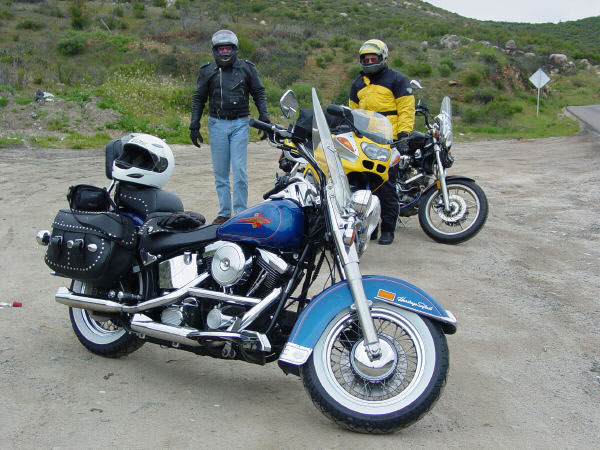So I had my new Harley, a gorgeous blue ’92 Heritage Softail, and it was a shockingly beautiful motorcycle. Yeah, some of the styling touches were a little hokey, but in a good way. I never even knew what a concho was before I bought the Softail, but I knew after I owned it. I became a Harley-riding cowboy. The conchos made the bike complete. How I ever made it to 40 without conchos I’ll never know. I had them now, though, and they just looked right. My Softail was a fashion statement. It made me look good and it made me feel good. I loved that bike.

There was only one problem, and it was a big one: The Softail was a dawg. It was a 700-lb lump that couldn’t get out of its own way. I’ve already spoken about how unreliable my ’79 Electra-Glide was, but that old clunker would get up and choogy, and it would have walked away from my new ’92 Softail in a drag race. I mean, the thing was slow. When I gave it more throttle going up a hill, it seemed like the only result was a deeper moan. It sure didn’t go any faster.
I worked in El Monte in those days and the nearby dealer was a famous one in southern California, Laidlaw’s, and I felt comfortable with them. I knew Bob Laidlaw, their founder, and I knew his son Jerry, and I knew both to be straight shooters. When it was time for the Softail’s first service at 500 miles, that’s where I went. Laidlaw’s has since moved to a larger, more modern facility in a better neighborhood, I’m guessing at Harley-Davidson’s insistence, and it’s still a great place. But I liked the old location better. Like I described for Dale’s in the last blog about buying my ’92, the old Laidlaw’s facility had that crusty old motorcycle shop schtick, and I liked that. You know, grease on the floor, a funky shop area, and guys who looked like their lives revolved around motorcycles and tattoos. Guys with calibrated arms who knew how much torque to apply to a 9/16 by feel alone.
I went to Laidlaw’s on an overcast Saturday morning for that first service, and Jerry wrote the service order. After completing it, he looked at me and asked: Anything else?
“Yeah,” I said. “The thing’s a dog.”
Jerry smiled. He knew. This wasn’t his first rodeo.
“They lean them out pretty good from the factory,” he said.
“So what do guys do?” I asked.
Another Jerry smile. “Well, most guys get a new cam, punch out the pipes, rejet the carb, and put the Screaming Eagle air filter in.”
“How much is that?” I asked. I could see this smoking past another $1500 without stopping to look back.
“It’s about $500,” Jerry answered. Hmmm, that wasn’t as bad as I thought it would be.
“So how much would everything be,” I said. “You know, the 500-mile service and the cam and carb and pipes and all the rest?”
“It’s $500 for everything,” Jerry answered, “including the 500-mile service.”
I could hardly believe what I was hearing.
“Let’s do it,” I said. I mean, I know a good deal when I see one. I hung around, as Jerry told me the whole thing would be a couple of hours. In the meantime, it had started raining, and I had no raingear. I walked across the street to some sort of an Army-Navy-99-cent store and bought a $3 rain suit.
In those days, it was no big deal to hang around in the service area and watch the techs work on your bike. The guy who was working on mine was a long-haired dude with lots of tattoos and a friendly smile. He held this giant steel toothpick-looking sort of tool that was essentially a ¾-inch-diameter rod sharpened to a point in one hand, and in his other hand he had a sledge hammer. He stuck the persuader into the end of one of my fishtail mufflers and whacked it with the sledge hammer. Then he repeated the process on the other fishtail. With a big grin, he said, “Adios, baffles!”
Then it was the carb work and the air cleaner replacement. And then it was the Screaming Eagle cam, which actually was pretty easy to install in the chrome cone on the right side of the engine. Then he buttoned it all up.
I finished my cup of coffee, donned my el cheapo raingear, paid my bill, and fired up the Harley.
Good Lord!
It was a completely different motorcycle. It sounded way better than it had before the Screaming Eagle cam work and exhaustectomy. It had been transformed from a smothered, anemic, pathetic, wheezing sort of thing into living, breathing, fire-snorting, spirited motorcycle. It reeked raw power and it had attitude. The idle was lopey and assertive, like a small block Chevy with an Isky cam and Hooker headers. My Harley rocked back and forth on its axles with each engine rotation. It was telling me: Let’s go! I think I’m pretty good at turning a phrase and I’m doing my best here, folks, but trust me on this: It’s hard to put into words how complete and total my Harley’s transformation was. It kind of reminded me of the first time I ever threw a leg over a Triumph Bonneville (I was 14 when that happened, and when Laidlaw’s tuned my Softail I was 14 all over again).
So I rolled out into the rain for my 30-mile ride home and I was afraid to whack the throttle open. I thought the rear wheel would break loose on the wet pavement; it felt that powerful. The rain and the clouds, I think, made the Harley’s Exhaust Notes (love that phrase) sound way mo better. I was there, man.
Don’t ever miss an ExNotes blog! Sign up here…
